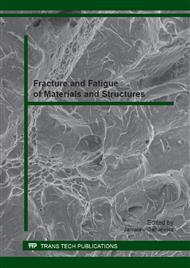[1]
Bažant Z. P., Size effect in blunt fracture concrete, rock, metal, Journal of Engineering Mechanics ASCE 110 (1984) 518-535.
DOI: 10.1061/(asce)0733-9399(1984)110:4(518)
Google Scholar
[2]
Brueggeman W.C., Mayer M. Jr., Axial fatigue tests at zero mean stress of 24S-T and 75S-T aluminum-alloy strips with a central circular hole, NACA 1611 (1948).
Google Scholar
[3]
Çam G., Erim S., Yeni., Koçak M., Determination of mechanical and fracture properties of laser beam welded steel joints, Welding Research Supplement To The Welding Journal (1999) 193-201.
DOI: 10.1179/stw.1998.3.4.177
Google Scholar
[4]
Carpinteri A., Spagnoli A., Vantadori S., An approach to size effect in fatigue of metals using fractal theories, Fatigue & Fracture of Engineering Materials & Structures 25 (2001) 619-627.
DOI: 10.1046/j.1460-2695.2002.00506.x
Google Scholar
[5]
Carpinteri A., Spagnoli A., Vantadori S., Size effect in S-N curves: A fractal approach to finite-life fatigue strength, International Journal of Fatigue 31 (2009) 927-933.
DOI: 10.1016/j.ijfatigue.2008.10.001
Google Scholar
[6]
Furuya Y., Notable size effects on very high cycle fatigue properties of high-strength steel, Materials Science and Engineering A 528 (2011) 5234-5240.
DOI: 10.1016/j.msea.2011.03.082
Google Scholar
[7]
Hirose T., Tanigawa H., Ando M., Suzuki T., Kohyama A., Katoh Y., Narui M., Evaluation of creep fatigue properties with miniature hourglass specimen, Small Specimen Test Techniques: Fourth Volume (2002) 181-194.
DOI: 10.1520/stp10820s
Google Scholar
[8]
Hyler W. S., Lewis R. A., Groverh J., Experimental investigation of notch-size effects on rotating-beam fatigue behaviour of 75S-T6 aluminum alloy, NACA 3291 (1954).
Google Scholar
[9]
Kocańda S., Szala J., Bases of fatigue calculation [in Polish], PWN (1997).
Google Scholar
[10]
Lord J., Orkney L., Roebuck B., Validation of a miniature tensile strength measurement system, Small Specimen Test Techniques: Fourth Volume, Journal of ASTM International (2002) 234-250.
DOI: 10.1520/stp10824s
Google Scholar
[11]
PN-74/H-04327 The study of metal fatigue. The test of axial tension - compression at constant cycle of external loads [in Polish].
Google Scholar
[12]
PN-EN ISO 6892-1:2010 Metals - Tensile testing - Part 1: Test method at room temperature [in Polish].
Google Scholar
[13]
Sokolov M., Small Specimen Test Techniques: 5th Volume, Journal of ASTM International (2009).
Google Scholar
[14]
Sonsino C. M., Course of SN-curves especially in the high-cycle fatigue regime with regard to component design and safety, International Journal of Fatigue 29 (2007) 2246-2258.
DOI: 10.1016/j.ijfatigue.2006.11.015
Google Scholar
[15]
Sosnovski L. A., Size effect in bending fatigue resistance of carbon and low-alloy steel and its prediction, Strength of Materials 10 (1978) 392-399.
DOI: 10.1007/bf01523786
Google Scholar
[16]
Sosnovski L. A., Statistical model of a deformable solid with a critical volume and some of its applications, Strength of Materials 22 (1990) 626-632.
DOI: 10.1007/bf00806260
Google Scholar
[17]
Tomaszewski T., Sempruch J., Determination of the fatigue properties of aluminum alloy using mini specimen, Material Science Forum 726 (2012) 63-68.
DOI: 10.4028/www.scientific.net/msf.726.63
Google Scholar
[18]
Tomaszewski T., Sempruch J., Stand for fatigue tests of mini specimen under variable tensile, Materials XXIV Symposium on Fatigue and Fracture Mechanics, Institutional Publications University of Technology and Life Sciences in Bydgoszcz [in Polish] (2012) 147-148.
Google Scholar
[19]
Troshchenko V. T., Sosnowski L. A., Fatigue resistance of metals and alloys, Academy of Sciences of the Ukrainian SSR [in Russian] (1987).
Google Scholar
[20]
Weibull W., The phenomenon of rupture in solids, Royal Swedish Institute For Engineering Research 153 (1939) 1-55.
Google Scholar
[21]
Weibull W., A statistical distribution function of wide applicability, Journal of Applied Mechanics ASME 18 (1951) 292-297.
Google Scholar


